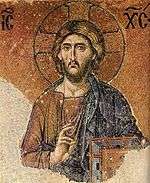Chuvash people
The Chuvash people (/tʃʊˈvɑːʃ/; Chuvash: чăваш, IPA: [t͡ɕəˈʋaʂ]; Russian: чуваши, pronounced [t͡ɕʊˈvaʂɨ]) are a Turkic ethnic group, native to an area stretching from the Volga Region to Siberia. Most of them live in the Republic of Chuvashia and surrounding areas, although Chuvash communities may be found throughout the Russian Federation.
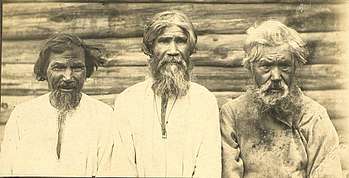 Group of aged Chuvash men, early 20th century. | |
| Total population | |
|---|---|
| c. 1.5 million | |
| Regions with significant populations | |
| 1,435,872[1][2] | |
| 22,305[3] | |
| 10,593[4] | |
| 10,074[5] | |
| 2,281[6] | |
| 2,242[7] | |
| 1,204[8] | |
| 900 | |
| 848[9] | |
| 542[10] | |
| 534[11] | |
| 489[12] | |
| 373[13] | |
| Languages | |
| Chuvash Russian | |
| Religion | |
| Predominantly: Irreligiosity, Russian Orthodox Christianity Minority: Islam | |
| Related ethnic groups | |
| Volga Tatars, Mari people | |
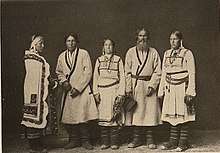
.png)
Etymology
There is no universally accepted etymology of the word Chuvash, but there are two main theories that try to explain it: one suggests that the word Chuvash may be derived from Common Turkic jăvaš ('friendly', 'peaceful'), as opposed to şarmăs ('warlike'). Another theory is based on the Tabghach, an early medieval Xianbei clan and founders of the Northern Wei dynasty in China. The Old Turkic name Tabghach (Tuoba in Mandarin) was used by some Inner Asian peoples to refer to China long after this dynasty. Gerard Clauson has shown that through regular sound changes, the clan name Tabghach may have transformed to the ethnonym Chuvash.[14]
Subgroups
Chuvash people are divided into three main groups:[15]
History
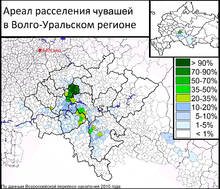
The Turkic ancestors of the Chuvash people are believed to have come from central Siberia, where they lived in the Irtysh basin (between the Tian Shan and Altay) from at least the end of the third millennium BC. In the beginning of the first century AD, the Bulgars started moving west through Zhetysu and the steppes of modern-day Kazakhstan, reaching the North Caucasus in 2nd–3rd centuries AD. There they established several states (Old Bulgaria on the Black Sea coast and the Suar Duchy in modern-day Dagestan.
Old Bulgaria broke up in the second half of the 7th century after a series of successful Khazar invasions. Some of its population fled north, to the Volga-Kama region, where they established Volga Bulgaria, which eventually became extremely wealthy: its capital being the 4th largest city in the world. Shortly after that, the Suar Duchy was forced to become a vassal state of Khazaria. About half a century later, the Suars took part in the Arab–Khazar wars of 732–737. The adoption of Islam in the early tenth century in Volga Bulgaria led to most of its people (including the Chuvash) to embrace the religion.[16]
After the collapse of Volga Bulgaria by the Mongols in 1236, the Golden Horde kept control of the region until its slow dissolution in 1438. The Kazan Khanate then became the new authorities of the region and of the Chuvash. The modern name 'Chuvash' began to appear in records starting from the sixteenth century from Russian and other foreign sources.[16]
In 1552, the Russians conquered the Kazan Khanate and its territories. The subsequent centuries saw the Christianization and Russification of the Chuvash. During this period, most Chuvash converted to Orthodox Christianity (sometimes by force) but Russification was never achieved. However, a few Chuvash continued being Muslim.[16]
The eighteenth and nineteenth century saw the revival of Chuvash culture and the publication of many educational, literary, and linguistic works along with the establishment of schools and other programs. The Chuvash language began being used in local schools and a special written script for the Chuvash language was created in 1871.[16]
On June 24, 1920, the Chuvash Autonomous Region was established but was renamed the Chuvash Autonomous Soviet Socialist Republic in April 21, 1925. Around this time saw the rise of Chuvash nationalism but the Soviet authorities attempted to suppress these nationalist movements by redrawing the borders of the republic so that many Chuvash will be living in neighboring republics or Russian districts. During most of the Soviet period, the Chuvash were subjected to Russification campaigns and propaganda. The Chuvash language vanished from educational and public use. In 1989, another Chuvash cultural revival began partly in response to these changes. Soon, the Chuvash language was once again used in educational, public, and political life.[16]
Today, the Chuvash language and culture is taught in schools in the Chuvash Republic and in areas outside that have large Chuvash populations. Chuvash around Russia also have media available to them in their local communities.[16]
Origin
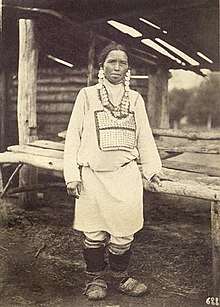
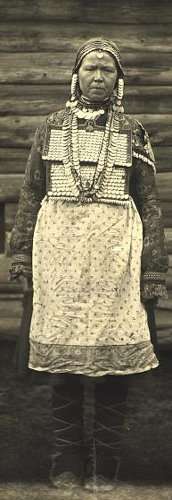
According to one theory, the Chuvash may be descended from the Volga Bulgars.[17]
They have been subjected to much infusion and influence, not only from Russian and Turkic peoples, but also from neighboring Finnic tribes, with whom they were persistently and mistakenly identified for centuries, perhaps aided by the fact that the Chuvash language is a highly divergent form of Turkic, and was not easily recognized as such.[17] Chuvash is classified, alongside the extinct Bulgar language, as the only remaining member of the Oghuric branch of the Turkic language family.
Genetics
Chuvashes are autosomally approximately 75% West Eurasian and 25% East Eurasian on average.
The two main Y-DNA haplogroups amongst the Chuvash are R1a (Z282 and Z93) at the frequency of 28-32% and N-B211 at about 20%.[18] R1a haplogroup peaks in the Kyrgyz at 63% and is present at 57,5% in Poles. N-B211 reaches its highest frequency at 67% in Udmurts[18] and is also found in approximately 20% of Komis and Ugrians and in approximately 10% of Maris and Mordvins. In lower frequencies other haplogroups also found amongst the Chuvash are E-M78, N-P43 (especially N-L1419), J2, I1, R1b, I2a, J1a and C.[15]
Culture
They speak the Chuvash language and have some pre-Christian traditions. The Chuvash language is Turkic and is the only Oghur Turkic language that survives. The language has been influenced by Tatar, Russian, and Finno-Ugric languages. It has two to three dialects.[16] In addition to Chuvash,[19] many people also use the Russian language.
Religion
Today Chuvash people are Eastern Orthodox Christians and belong to the Russian Orthodox Church. They retain some pre-Christian Tengrism traditions in their cultural activities. They syncretized Orthodox Christianity and Tengriism. Parallel pray in the shrines called keremet and sacrifice geese there. One of the main shrines is located in the town of Bilyarsk. There are some Chuvash who follow Islam which also has many traces of pre-Islamic beliefs and rituals.[16]
See also
| Wikimedia Commons has media related to Chuvash people. |
References
- Census 2010
- Census 2002
- "Демоскоп Weekly - Приложение. Справочник статистических показателей". Demoscope.ru. 2013-03-21. Archived from the original on 2011-06-04. Retrieved 2016-02-09.
- "Всеукраїнський перепис населення 2001 - English version - Results - Nationality and citizenship - The distribution of the population by nationality and mother tongue - Selection". 2001.ukrcensus.gov.ua.
- "Демоскоп Weekly - Приложение. Справочник статистических показателей". Demoscope.ru. 2013-03-21. Archived from the original on 2012-03-14. Retrieved 2016-02-09.
- "НАЦИОНАЛЬНЫЙ СОСТАВ НАСЕЛЕНИЯ РЕСПУБЛИКИ БЕЛАРУСЬ (ETHNIC COMPOSITION OF POPULATION OF THE REPUBLIC OF BELARUS)". Archived from the original on February 7, 2009. Retrieved October 21, 2009.
- "Демоскоп Weekly - Приложение. Справочник статистических показателей". Demoscope.ru. 2013-03-21. Archived from the original on 2016-01-25. Retrieved 2016-02-09.
- "Демографические тенденции, формирование наций и межэтнические отношения в Киргизии". Demoscope.ru. Archived from the original on 2016-02-06. Retrieved 2016-02-09.
- "Демоскоп Weekly - Приложение. Справочник статистических показателей". Demoscope.ru. 2013-03-21. Retrieved 2016-02-09.
- "Демоскоп Weekly - Приложение. Справочник статистических показателей". Demoscope.ru. 2013-03-21. Archived from the original on 2011-08-26. Retrieved 2016-02-09.
- "RAHVASTIK RAHVUSE, SOO JA ELUKOHA JÄRGI, 31. DETSEMBER 2011". pub.stat.ee.
- Gerard Clauson, Studies in Turkic and Mongolic Linguistics. Routledge, 2002, p. 23.
- "Family Tree DNA - Genetic Testing for Ancestry, Family History & Genealogy". www.familytreedna.com.
- Skutsch, Carl, ed. (2005). Encyclopedia of the World's Minorities. New York: Routledge. pp. 312, 313. ISBN 1-57958-468-3.
- John R. Krueger, Chuvash Manual. Introduction, Grammar, Reader, and Vocabulary (Hague, 1961), 7–8.
- Ilumäe 2016
- ""Haval" somera tendaro 2015 | Чувашская общественная организация "Хавал"". Cv-haval.org (in Russian). Retrieved 2016-02-09.
